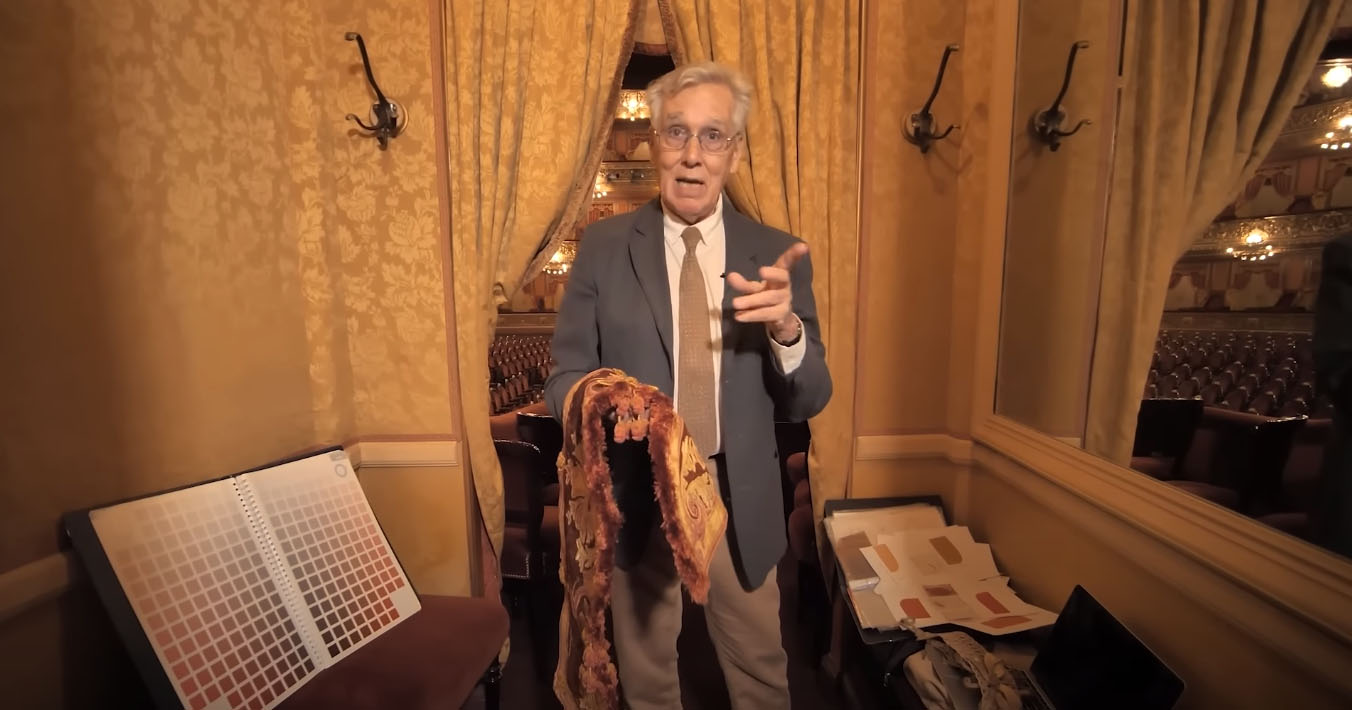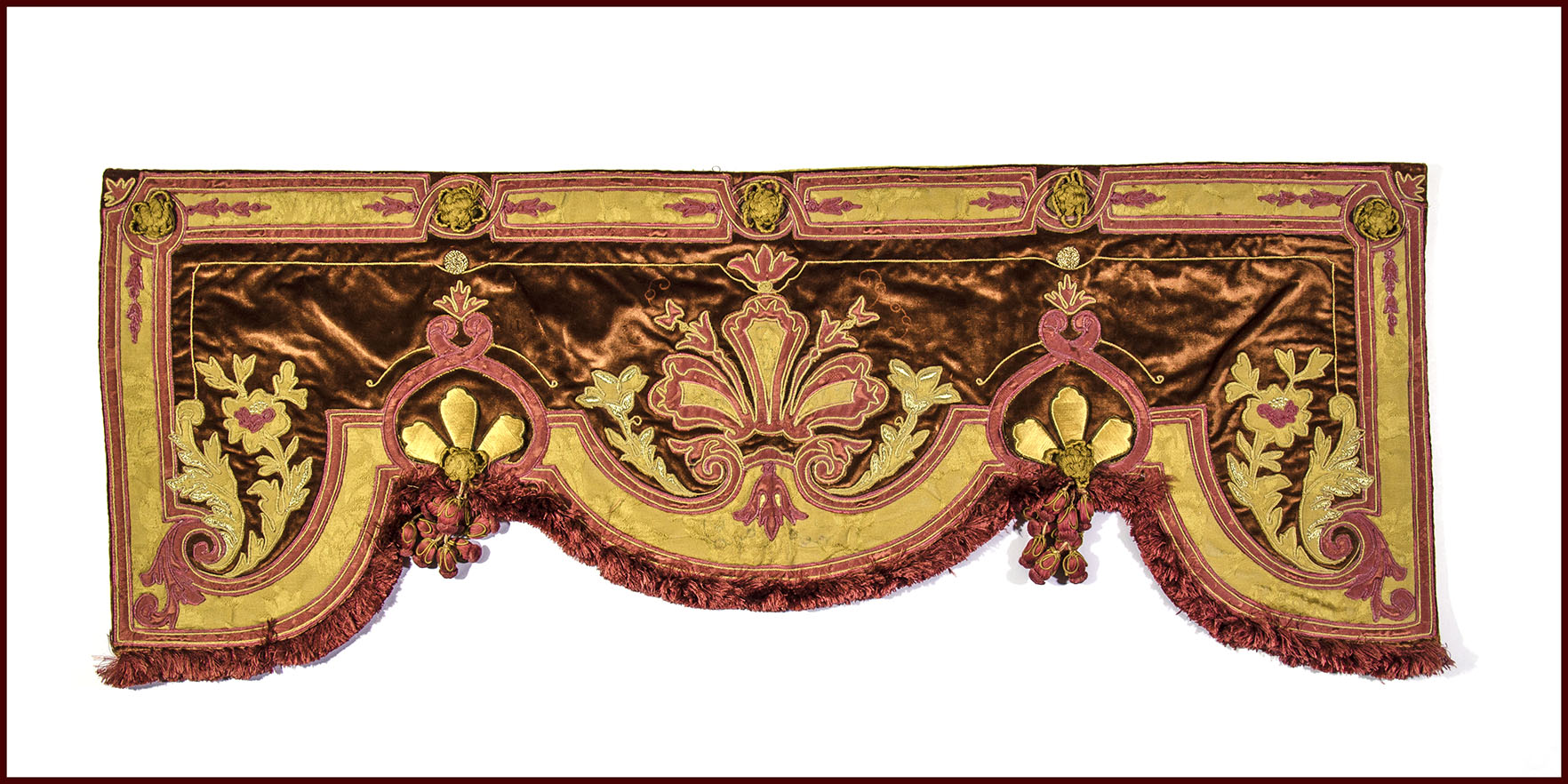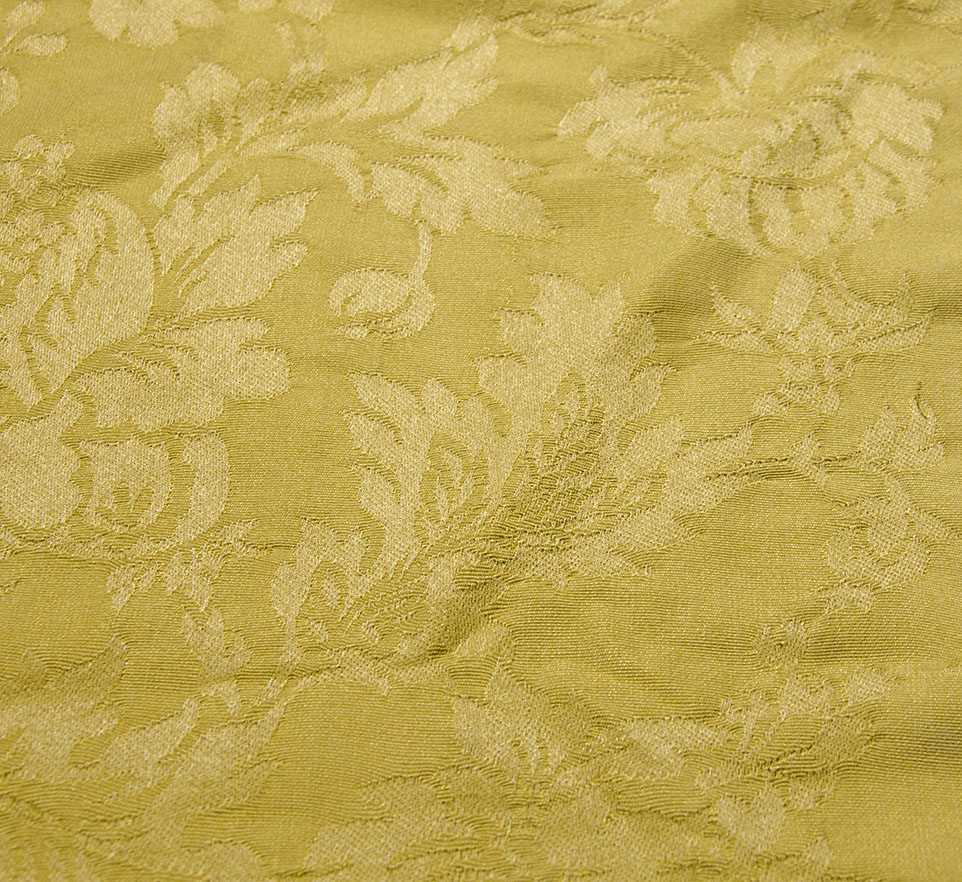The work of an interior designer, according to the American Society of Interior Designers consists of "The identification, investigation and creative resolution of the problems of the interior environment". This motto has guided me in every professional challenge and it has also been the one that led me to accept Hilario's hospitality to give testimony of my intervention in the replacement of the textiles of the Sala del Teatro Colón in Buenos Aires between November 2006 and November 2007, at the request of my friend Enrique Salvatierra and Esther Galante, my adventure partner on that occasion. To them was added the invitation of Teresa de Anchorena to present on the subject in the Course "History and Geography of the Teatro Colón", which is being developed at this moment.
I accepted the designation as “textile advisor” of the Teatro Colón Master Plan the second time it was proposed to me on behalf of Architect Silvia Fajre, then Minister of Culture of the City. She had declined a previous offer because she had been a party to the ongoing controversy over the proposed task. Teresa de Anchorena, legislator and member of the National Commission of Monuments, Places and Historical Assets (CNMLBH) questioned the replacement of the room's textiles, which the specification sheet required, and advocated the restoration and reuse of the originals ; she had consulted me about it. [1] My inquiries about the state of what exists for the next fifty years advised against this proposal, so I decided to accept the following invitation with that position taken. It would not be within my competence to modify the specifications already approved, tendered and awarded, nor any executive attribution. My role would be that of an external consultant. Only a political decision, not a technical one, could have altered this state of affairs and that is what happened when the Macri management made the decision not to reproduce the formidable mouth curtain of 1931, as required by the tender, and to compete for a new design. Decision that I will analyze in the May issue of the Hilario digital magazine.
The controversy surrounding the path chosen by the Master Plan was addressed by Sol Dellepiane in D&D magazine, in its December 2007 issue: “Not everyone agrees on the decisions that have been made regarding the historic textiles in the Main Room. The Legislature's Special Commission for Architectural and Landscape Heritage has presented two reports in which it is in favor of preserving pieces such as the curtain and box curtains, both for their aesthetic and cultural value and for their impact on the venue acoustics. According to these writings, "the textiles occupy a prominent place, however, they do not receive the same treatment as the other ornamental elements of the room, for which the conservative restoration criterion is applied." Weighty voices endorse the position of this Commission, whose most visible exponent is Buenos Aires Deputy Teresa Anchorena, a staunch defender of the cultural heritage of Argentines. On the one hand, Theater workers have sent two letters to the current Head of Government advocating in favor of the restoration and offering to carry out the task in a timely manner.
In monumental buildings, maintenance is always meager, and major interventions occur every 50 or 100 years, as in this case. Such a practice advises that, when the political decision to make an effort is reached, the prudent thing to do is to do so anticipating that it will be sustained for the same period of time. In the middle of the debate on the path to follow, the curious thing about the case is that from both positions they advocated said effort and the necessary investment, and all proclaimed the maintenance of "Colón quality" as a standard of measurement. In this context I started my task.
As soon as I signed a first report on the existing samples available, I received a call from Esther Galante, a well-known textile businesswoman, owner of the Ronchamp house, who was hesitating to accept textile advice for San José, the winning company. Because of her suitability and her unreflective enthusiasm, I insisted that she accept to have a suitable interlocutor in the contractor, and thus an unexpected team was formed.
The market and textile production in Argentina
For the provision of textiles for the restoration and technological updating of the Teatro Colón, the construction management qualified as acceptable only fabrics, trimmings and labor from those countries that have been and continue to be the production centers for decoration of the most quality in the world -he was referring to Italy, France and Germany-, custodians of a tradition of centuries, translated into the wealth of alternatives in yarns, dyes and technology, and in the excellence of those textile technicians who produce the goods offered by the most internationally recognized brands.
This is not a strength that the Argentine textile industry boasts, protected from all competition and oriented towards standardized production for a low-demand mass market. In our environment the productive tradition of decorative art is of recent date, and textiles do not have a leading role in it. Those of greater sophistication and quality have traditionally been provided by the European market, as in the case at hand.
Natural silk is not produced in Argentina, nor viscose (artificial recovery of cellulose and cotton), nor metallic threads of interfine gold, nor linen fiber, nor polyester with the Trevira CS trademark, essential for fire-retardant qualification, nor other similar yarn that satisfies her. These restrictions entail limitations on complementary industries, such as dyeing, spinning, and weaving. Cotton fiber spinning does not go beyond count 48/1 Ne, which bypasses all finer counts up to 120/1 Ne. The English cottons produced by Liberty, for example, are woven with 60/1 count yarn. The thinner yarns produce higher quality fabrics, which do not find here the demand that sustains or justifies the necessary investments. What naturally limits the possibilities of experimentation and practice in the training of artists, craftsmen and technicians.
Homework
International flame retardant prevention standards for the various fibers stood in the way of an exact reproduction of the original genres. Cotton, interdict, silk and wool questioned, and for curtains and curtains, only Trevira CS, a specifically fire-retardant polyester fiber, would be accepted. This required verifying the benefits of this new fiber in texture, color and shine; as well as identify the different possible qualified suppliers.
The samples that came into his hands, of tiny dimensions. Photography: Nicolas Vega.
In order to fulfill the assigned mission, the starting documentation -samples of the original genres- was scarce, confusing and very limited, due to the controversy over their preservation or reproduction, which limited the possibility of having samples of a reasonable size. We had them -in few pieces of fabric 4 cm per side- in the following genres: 1) Velvet Armchairs; 2) Damascus for box curtains; 3) Brocades for box curtains and antebox scrims; 4) Carved twill for scrims between boxes; 5) Damask for the official box and 6) Velvet for Bandeaux of boxes. Not so of the necessary fabric for the curtains of passage, nor of the carpets.
Given its very small dimensions, I decided to unravel the samples of all the textiles to be replaced, in order to accurately identify the composition and characteristics of each intervening yarn, as well as its color. For this, I had the assistance of the company ALBA SA and its excellent Language of Colors catalogue, which offered to make a color smear for each yarn sample free of charge, as a contribution to the success of the task. Laboratory analyzes completed the starting information.
The next step was to require the contractor to submit yarn samples with the chosen color. In the case of damasks and brocades: three warp samples and three weft samples for each genre, with the shades indicated by the Project Manager, based on the patterns and the aforementioned catalogue.
Thus, as of July 24, 2007, I presented the progress achieved in a report to the Master Plan that I summarize below.
1. Velvet Seats: For the seats and railings of the boxes, the fire-retardant advisors authorized the use of wool velvet, a self-extinguishing fiber because it is of animal origin. It was decided to hire a company from Nole, near Turin (Italy). The late verification that the original velvet was made of goat's wool (mohair), did not allow, much to my regret, to review the decision made in the document, due to a difference in costs.
2. Damascus: It was decided to request samples with 20% silk warp and 80% Trevira weft, with which a texture and shine very similar to the original was achieved. That decision was accepted by the fire retardant advisors, and was based on avoiding gloss deficiencies noted on a previous trip of mine, in the textiles used in the ongoing refurbishment at La Scala in Milan. The use of rare 1.28 m wide looms made it possible to reproduce exactly the dimensions of the original damask pattern.
3. Brocato: Samples of the original genre featured different tones. Those presented by the company were satisfactory from the point of view of the drawing with a loom -this time 1.38 wide- and of the texture, yarn counts and shine. It would need to be compared with the damask and velvet of the bandeaux, for final approval.
4. Twill: With 20% silk warp and 80% Trevira weft, a texture and shine very similar to that of the original 100% silk was achieved. The same color would be used in the warp as for the damask of the curtains of the boxes, reinforcing the unity of the whole.
5. Damascus official box: The vertical rapport of the drawing is 0.70 m, and the height from the chair rail to the ceiling of the box is 1.35 m. The choice of this genre has not been adequate, even if it is historical, because such a rapport is contraindicated for such a height. It was suggested to replace it with the twill of the scrim between the boxes, with a pattern whose pattern is much smaller, leaving the most important pattern (approximately 0.45 m) of the damask curtains. Ditto for the scrims of the avant-scène, presidential and mayor's boxes. The proposal was approved.
6. Velvets for curtains, curtains and bandeaux for boxes: The shine of Trevira CS velvet does not come remotely close to that of the original cotton velvet in the case of curtains and bandeaux, and its receptivity for appliqués and embroidery is less . To define the color of the velvet of the curtain, it was proposed to take the colors of the Mantle of Harlequin (1908) as a reference, and select those of the applications on the basis of the background to be adopted. To date, there was no satisfactory color sample from the selected supplier. In the case of small pieces, but of high decorative value, the request for the bandeaux was reconsidered, authorizing the use of cotton or silk velvet.
7. It could be assumed that the curtains were originally made with the same fabric as the seats, as seemed to be the case at the time the work began, although in no case were they old textiles. This coincidence was unsustainable in terms of the specifications, since they had to be from Trevira CS. Otherwise they should be replaced by glass doors. Because the aging and electrostatic behavior of wool and Trevira are different, my suggestion was that the seats and curtains should not have the same color. A color on paper was approved, ad referendum of the sample to be presented by the contractor.
8. The rug lacked an original sample, so we were free to choose its color.
The color scheme
We were before a kaleidoscope of samples, some original and others later, difficult to date. The reform of the 1960s turned the color of the room to garnet or burgundy, in seats, curtains, carpets and painting of boxes and anteboxes. In the absence of an explicit or ostensible criterion, it was difficult to dispense with personal inclination to make the unavoidable decisions.
A moral dilemma for me, whose solution arose one autumn afternoon when, rowing along the Tigre River, I saw the fallen leaves of willow, sweetgum, acer and eucalyptus pass by. I found surprised that there was the palette I was looking for. I collected and organized them in a kind of herbarium, where I was able to identify the existing color samples, and with it, reasonably correct, add or eliminate irrelevant colors. My proposal to formulate a key to intersubjective understanding was approved by the Master Plan.
A providential “tool”, the leaf sampler that allowed him to identify the autumnal palette used. Photography: Nicolas Vega.
From there, the color samples for the yarns to be woven were requested. Counting on options for the warp and the weft, there was the possibility of doing tests with the chosen warp and three weft tones, in order to, combining the rest of the samples, choose the most suitable one.
In the case of wool velvet, the parcel was almost 5,000 meters or 5 kilometers (!). The selection of colors for the curtain and curtains due to color deficiencies in the samples presented by the selected supplier were also pending resolution. However, the Master Plan did not foresee the trip of any of its representatives to resolve these pending problems with their presence. And to make themselves known and personally meet those responsible for such an important contract.
I then decided to take this problem to Nelly Arrieta de Blaquier, a great friend, generous and discreet patron of the Teatro Colón Foundation, among many other activities. She agreed to rectify it and arranged to pay through the Foundation for the ticket and lodging -without fees- for a representative of the Masterplan, who finally decided to entrust me with that responsibility, a proposal that I decided to accept. This is how, with Esther Galante representing the winning company in Argentina, we visited the different contracted suppliers in Nole, Caserta and Nápoles, in Italy. And in Germany, where we chose the colors of the Trevira velvets from the archive of the selected factory, which saved the unresolved problem of the dry cleaners. To avoid the phenomenon called metamerism, alteration of the behavior of the pigments before the different sources of light, the supplier had a light camera available to our request to verify the samples to be chosen.
SEE VIDEO The architect Germán Carvajal addresses the issue of the color of the various textiles used for the restoration of the Teatro Colón. The few original references and the final decision in the choice. You can see the complete conference on the Youtube channel of the Teatro Colón: SEE VIDEO
Notes:
1. At that time, he had even proposed to appoint me as an adviser to the CNMLBH, an appointment that did not take effect.


